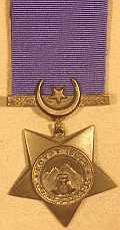Egypt Medal and Khedive’s Star
Soldiers who fought in Egypt between 1882 and 1889, regardless of rank, were presented with the Egypt Medal and the Khedive’s Star. The Egypt Medal is made from silver; the obverse (front) has Queen Victoria’s head and the Latin inscription ‘Victoria Regina et Imperatrix’ [Victoria, Queen and Empress] and the reverse (back) has a Sphinx and the inscription ‘Egypt.’


The ‘Record of Services of the Durham Light Infantry (2nd Battalion)’
[D/DLI 2/2/135] records that the Egypt Medal was presented to the battalion on 17 December 1886, in Cairo:
‘General Sir Frederick Stephenson, G.C.B., commanding in Egypt, having expressed a wish to himself present the medals won at the Battle of Ginnis, the battalion paraded for this purpose on December 17.’
The men were inspected and the medals presented, then ‘the general addressed the regiment, expressing the gratification it had given him to present the medals, and his appreciation of the work done by the Durham Light Infantry in the campaign which was ended by the important and decisive victory at Ginnis, and also with the general conduct and smart bearing of the battalion whilst in Egypt.’
On 4 July 1888, in Poona, India, the Khedive’s Star was presented to ‘the officers and men of the battalion who had served in the Egyptian campaign’ by H.R.H. the Duke of Connaught, Commander in Chief of the Bombay Army. The Khedive ruled Egypt under British control and he awarded this bronze five-pointed star to all men who received the Egypt Medal. The obverse (front) shows the Sphinx, with the Pyramids behind and the reverse (back) is blank.


